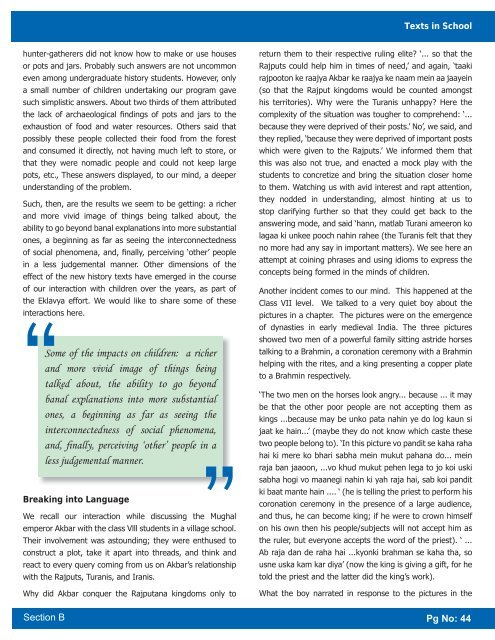Indesign Pagesnew.indd - Azim Premji Foundation
Indesign Pagesnew.indd - Azim Premji Foundation
Indesign Pagesnew.indd - Azim Premji Foundation
Create successful ePaper yourself
Turn your PDF publications into a flip-book with our unique Google optimized e-Paper software.
hunter-gatherers did not know how to make or use houses<br />
or pots and jars. Probably such answers are not uncommon<br />
even among undergraduate history students. However, only<br />
a small number of children undertaking our program gave<br />
such simplistic answers. About two thirds of them attributed<br />
the lack of archaeological fi ndings of pots and jars to the<br />
exhaustion of food and water resources. Others said that<br />
possibly these people collected their food from the forest<br />
and consumed it directly, not having much left to store, or<br />
that they were nomadic people and could not keep large<br />
pots, etc., These answers displayed, to our mind, a deeper<br />
understanding of the problem.<br />
Such, then, are the results we seem to be getting: a richer<br />
and more vivid image of things being talked about, the<br />
ability to go beyond banal explanations into more substantial<br />
ones, a beginning as far as seeing the interconnectedness<br />
of social phenomena, and, fi nally, perceiving ‘other’ people<br />
in a less judgemental manner. Other dimensions of the<br />
effect of the new history texts have emerged in the course<br />
of our interaction with children over the years, as part of<br />
the Eklavya effort. We would like to share some of these<br />
interactions here.<br />
Some of the impacts on children: a richer<br />
and more vivid image of things being<br />
talked about, the ability to go beyond<br />
banal explanations into more substantial<br />
ones, a beginning as far as seeing the<br />
interconnectedness of social phenomena,<br />
and, fi nally, perceiving ‘other’ people in a<br />
less judgemental manner.<br />
Breaking into Language<br />
We recall our interaction while discussing the Mughal<br />
emperor Akbar with the class Vlll students in a village school.<br />
Their involvement was astounding; they were enthused to<br />
construct a plot, take it apart into threads, and think and<br />
react to every query coming from us on Akbar’s relationship<br />
with the Rajputs, Turanis, and Iranis.<br />
Why did Akbar conquer the Rajputana kingdoms only to<br />
Section B<br />
Texts in School<br />
return them to their respective ruling elite? ‘... so that the<br />
Rajputs could help him in times of need,’ and again, ‘taaki<br />
rajpooton ke raajya Akbar ke raajya ke naam mein aa jaayein<br />
(so that the Rajput kingdoms would be counted amongst<br />
his territories). Why were the Turanis unhappy? Here the<br />
complexity of the situation was tougher to comprehend: ‘...<br />
because they were deprived of their posts.’ No’, we said, and<br />
they replied, ‘because they were deprived of important posts<br />
which were given to the Rajputs.’ We informed them that<br />
this was also not true, and enacted a mock play with the<br />
students to concretize and bring the situation closer home<br />
to them. Watching us with avid interest and rapt attention,<br />
they nodded in understanding, almost hinting at us to<br />
stop clarifying further so that they could get back to the<br />
answering mode, and said ‘hann, matlab Turani ameeron ko<br />
lagaa ki unkee pooch nahin rahee (the Turanis felt that they<br />
no more had any say in important matters). We see here an<br />
attempt at coining phrases and using idioms to express the<br />
concepts being formed in the minds of children.<br />
Another incident comes to our mind. This happened at the<br />
Class VII level. We talked to a very quiet boy about the<br />
pictures in a chapter. The pictures were on the emergence<br />
of dynasties in early medieval India. The three pictures<br />
showed two men of a powerful family sitting astride horses<br />
talking to a Brahmin, a coronation ceremony with a Brahmin<br />
helping with the rites, and a king presenting a copper plate<br />
to a Brahmin respectively.<br />
‘The two men on the horses look angry... because ... it may<br />
be that the other poor people are not accepting them as<br />
kings ...because may be unko pata nahin ye do log kaun si<br />
jaat ke hain...’ (maybe they do not know which caste these<br />
two people belong to). ‘In this picture vo pandit se kaha raha<br />
hai ki mere ko bhari sabha mein mukut pahana do... mein<br />
raja ban jaaoon, ...vo khud mukut pehen lega to jo koi uski<br />
sabha hogi vo maanegi nahin ki yah raja hai, sab koi pandit<br />
ki baat mante hain .... ‘ (he is telling the priest to perform his<br />
coronation ceremony in the presence of a large audience,<br />
and thus, he can become king; if he were to crown himself<br />
on his own then his people/subjects will not accept him as<br />
the ruler, but everyone accepts the word of the priest). ‘ ...<br />
Ab raja dan de raha hai ...kyonki brahman se kaha tha, so<br />
usne uska kam kar diya’ (now the king is giving a gift, for he<br />
told the priest and the latter did the king’s work).<br />
What the boy narrated in response to the pictures in the<br />
Pg No: 44

















